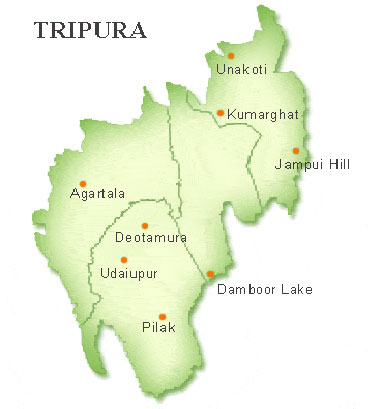History of Tripura
Tripura History: Tracing the Rich Cultural Legacy and Historical Significance.On January 26, 1950 Tripura was accorded the status of a ‘C’ category state and on November 1, 1956, it was recognized as a Union Territory. With the sustained efforts and struggle of the people of Tripura, it gained full statehood on January 21, 1972, as per the North-East Reorganisation Act, 1971.
Located in the northeastern part of India, Tripura is a state steeped in rich history and cultural heritage. Nestled between Bangladesh on three sides, Tripura holds a significant position in the region, offering a tapestry of traditions, legends, and historical events that have shaped its identity over the centuries. Let’s embark on a journey through Tripura’s history, exploring its ancient origins, royal dynasties, and the modern era.
Ancient Origins and Legendary Beginnings: Tripura’s history dates back to ancient times, with references found in Hindu scriptures and mythological texts. According to legend, the region was ruled by the Tripura Kingdom, believed to have been founded by the demon king Tripura, who was defeated by Lord Shiva. These legends highlight the ancient roots and cultural significance of the land.
Medieval Dynasties and Cultural Flourishing: From the 7th century onwards, Tripura witnessed the rise of various dynasties that left a lasting impact on the region. The most notable among them were the Manikya dynasty, which ruled for over five centuries. The Manikya kings not only consolidated their rule but also fostered the growth of art, literature, and architecture. They played a crucial role in shaping Tripura’s cultural landscape, and many magnificent temples, palaces, and monuments were constructed during their reign.
One of the prominent architectural marvels of that era is the Neermahal, a water palace built in the middle of Rudrasagar Lake. It exemplifies the fusion of Hindu and Muslim architectural styles, reflecting the inclusive and diverse nature of Tripura’s history.
Colonial Rule and Integration with India: During the British colonial era, Tripura became a princely state under the direct control of the British Empire. However, unlike many other regions, Tripura did not experience direct British administration. Instead, the Manikya kings retained their autonomy under the British suzerainty, preserving their culture and traditions.
Following India’s independence in 1947, the princely states were given the option to merge with India. In October 1949, Tripura joined the Indian Union, becoming a part of the newly formed Indian republic. This integration marked a significant turning point in Tripura’s history, leading to its economic, political, and social transformation.
Modern Era and Socio-economic Development: Since its integration with India, Tripura has made significant progress in various spheres. The state has witnessed rapid socio-economic development, with a focus on education, healthcare, infrastructure, and tourism. The government has implemented numerous schemes and initiatives to uplift the living standards of the people and promote inclusive growth.
Tripura’s rich cultural heritage remains a centerpiece of its modern identity. The state celebrates various festivals, including Garia Puja, Kharchi Puja, and Durga Puja, with great enthusiasm. These festivities not only showcase the vibrant traditions of Tripura but also attract tourists from all over the world.
The present-day Tripura is a thriving state, known for its natural beauty, serene landscapes, and warm hospitality. It has become a popular destination for nature lovers, adventure enthusiasts, and those seeking to explore the unique blend of history and culture.
Preservation of Cultural Heritage: Efforts have been made to preserve and promote Tripura’s cultural heritage. Museums, such as the Tripura Government Museum and Ujjayanta Palace Museum, house a vast collection of artifacts, manuscripts, and artworks, providing visitors with a glimpse into the glorious past of the region. Additionally, the state government has taken initiatives to revive and document traditional art forms, dance, music, and handicrafts, ensuring their preservation for future generations.
Tripura, a state located in northeastern India, has a total land area of approximately 10,491 square kilometers (4,050 square miles). It is bordered by Bangladesh on its three sides, with the country’s borders defining the length and breadth of the state. The state stretches approximately 184 kilometers (114 miles) from north to south and about 114 kilometers (71 miles) from east to west.
The capital of Tripura in 1949, following its integration with India, remained the same as it had been before. Agartala, located in the western part of the state, has been the capital of Tripura since the time of the princely state. After Tripura’s accession to India in 1949, Agartala continued to serve as the administrative and political center of the state. It remains the capital of Tripura to this day.
History of Tripura:- Tripura, a state in northeastern India, is known for its linguistic diversity. The official language of Tripura is Bengali, which is widely spoken and used for administrative and official purposes. However, several other languages are also spoken in the state, reflecting its multicultural character. Here are some of the prominent languages spoken in Tripura:
- Kokborok: Kokborok is an indigenous language spoken by the Tripuri people, who are the largest ethnic group in Tripura. It is recognized as one of the official languages of the state and holds cultural significance. Efforts have been made to promote and preserve Kokborok through education and cultural initiatives.
- Bengali: As the official language of Tripura, Bengali is widely spoken by the majority of the population. It is the primary language used in administration, education, and commerce. Bengali literature and culture have had a significant influence on Tripura’s society.
- Manipuri (Meitei): Manipuri, also known as Meitei, is spoken by the Meitei community, primarily residing in the Jiribam sub-division of Tripura. It has its roots in the neighboring state of Manipur and shares similarities with the Manipuri language spoken there.
- Chakma: The Chakma language is spoken by the Chakma community, which is predominantly found in the Chittagong Hill Tracts region of Tripura. The Chakma language belongs to the Tibeto-Burman family and has its own script.
- Mog: Mog is a language spoken by the Mog community, which is an ethnic group found in Tripura. It belongs to the Tibeto-Burman family and has its own distinct cultural and linguistic identity.
Apart from these languages, there are also communities in Tripura that speak languages like Reang (Bru), Halam, Garo, Mizo (Lushai), and other tribal languages. The linguistic diversity of Tripura contributes to its vibrant cultural fabric, and efforts are made to preserve and promote these languages through education and cultural initiatives.




